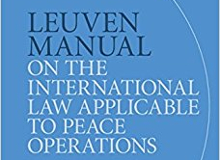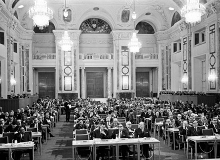
‘There is no going back.’ These were the words of Lord Pannick, uttered before the High Court in response to the question whether the United Kingdom could rescind its notification to withdraw from the European Union once issued under Article 50 TEU (Santos and M v Secretary of State for Exiting The European Union, uncorrected transcripts, p. 17). The claimants and the Government appear to agree on this point and accept that the UK cannot reverse its notification of withdrawal.
It is easy to see why this position should be attractive to both parties. For the Government, it means that once the notification has been issued in accordance with the UK’s constitutional requirements, it would be shielded from any subsequent domestic legal challenge. For the claimants, the irreversibility of the withdrawal notification is of ‘vital importance’ (uncorrected transcripts, p. 14). It is this irreversibility which, in their submission, pre-empts the powers of Parliament if the Government were to issue the notification without first obtaining the Parliament’s authorisation to do so.
The significance of this point was not lost on the Lord Chief Justice. He declined an invitation by counsel to assume that the withdrawal notification was irreversible and insisted that it was ‘absolutely essential’ for the Court to decide whether it was irrevocable or not (uncorrected transcripts, p. 192). In response, Lord Pannick confirmed that it was his position, as a matter of law, that there is no power to revoke the notification.
Earlier, Lord Pannick illustrated his position with the following analogy (uncorrected transcripts, p. 19):
I say my case is very simple. My case is that notification is the pulling of the trigger. And once you have pulled the trigger, the consequence follows. The bullet hits the target. It hits the target on the date specified in Article 50(3). The triggering leads to the consequence, inevitably leads to the consequence, as a matter of law, that the treatise cease to apply and that has a dramatic impact in domestic law.
Unfortunately for Lord Pannick, the analogy does not withstand closer scrutiny.
The applicable rules of interpretation
Whether a withdrawal notification is reversible or not is a question that turns on the interpretation of Article 50 TEU. Since Article 50 TEU forms part of an international agreement, its interpretation is governed not by English law, but by the rules of international law. Of course, as is well known, the Court of Justice of the European Union adopts a teleological approach to the interpretation of the EU’s founding Treaties which differs from the general rule of treaty interpretation laid down in Article 31 of the Vienna Convention on the Law of Treaties (VCLT). In particular, the Court lays greater emphasis on the aims and objectives of European integration than Article 31 VCLT might warrant (see Gardiner, Treaty Interpretation, pp. 136–137).
Leaving aside the longstanding doctrinal debates about the autonomous nature of the EU legal order, the fact remains that the founding Treaties of the EU are instruments of international law. It is therefore perfectly appropriate for a domestic court to construe Article 50 TEU by applying the rules of interpretation set out in the VCLT. In fact, this seems even more appropriate in the light of the subject matter of Article 50 TEU. It is no coincidence that the German Federal Constitutional Court interpreted Article 50 TEU against the background of the relevant provisions of the VCLT in its judgment in the Lisbon case (para 330).
What, then, are the applicable rules of interpretation? According to Article 31(1) VCLT,
A treaty shall be interpreted in good faith in accordance with the ordinary meaning to be given to the terms of the treaty in their context and in the light of its object and purpose.
Article 50(2) TEU stipulates that the Member State wishing to withdraw from the Union must notify the European Council of its intention. However, the text is silent as to whether a Member State subsequently may revoke its notification. In the absence of express terms, we have to consider whether an answer emerges from the text, context and the object and purpose of the treaty by implication.
The purpose of Article 50 TEU
According to Article 1 TEU,
By this Treaty, the HIGH CONTRACTING PARTIES establish among themselves a EUROPEAN UNION, hereinafter called “the Union”, on which the Member States confer competences to attain objectives they have in common.
It is difficult to find a more succinct statement of the object and purpose of the TEU: the establishment of an organisation upon which the Member States confer certain competences to attain certain shared objectives. These objectives are set out in greater detail in Article 3 TEU, while the scope of the EU’s competences is defined in Articles 3–6 of the Treaty on the Functioning of the European Union (TFEU). Article 5 TEU declares that the Union must act within the limits of the competences conferred upon it by the Member States and that competences not conferred upon the Union remain with the Member States. In Declaration 18 made appended to the Lisbon Treaty, the Member States recall these points and add that it is for them to increase or reduce the competences conferred upon the Union.
What emerges from these provisions is that the Union’s competences are based on the consent of its Member States and that the authority to increase or reduce these competences (sometimes described as Kompetenz-Kompetenz) remains firmly within their own hands. Article 50 TEU takes the principles of consent and conferral to their logical conclusion and confirms the right of a Member State to withdraw from the Union. In the words of the German Federal Constitutional Court, the ‘right to withdraw underlines the Member States’ sovereignty… If a Member State can withdraw based on a decision made on its own responsibility, the process of European integration is not irreversible.’ (Lisbon case, para 329). Against this background, we may conclude that the purpose of Article 50 TEU is to confirm in express terms the Member States’ ability to withdraw from the EU and to lay down the procedures for doing so.
The arguments against revoking the withdrawal
In his submissions before the High Court, Lord Pannick relied on three arguments to suggest that the UK would not be able to revoke its withdrawal notification once issued (uncorrected transcripts, p. 16–17):
Article 50 is deliberately designed to avoid any such consequence. There is no mention of a power to withdraw. And the very possibility of a power to withdraw a notification would frustrate, again, Article 50(3), which sets out in the clearest possible terms, what the consequences are of giving the notification under Article 50(2).
It is convenient to consider these arguments in reverse order.
- Frustrating the procedures
First, Lord Pannick suggests that revoking the withdrawal notification would frustrate the consequences attached to the notification by Article 50(3) TEU. According to that provision,
The Treaties shall cease to apply to the State in question from the date of entry into force of the withdrawal agreement or, failing that, two years after the notification referred to in paragraph 2, unless the European Council, in agreement with the Member State concerned, unanimously decides to extend this period.
Once notified, the withdrawal is inevitable, says Lord Pannick. That is the point of his bullet analogy: once fired, the bullet has to hit its target, either upon the entry into force of the withdrawal agreement, two years after the date of withdrawal notification or at the end of any extension period agreed between the UK and the European Council. There are two flaws with this reasoning. First, the completion of the procedures described in paragraphs (2) and (3) of Article 50 TEU is conditional upon the withdrawal notification. There is no logical reason why that withdrawal notification may not be revoked before those procedures are completed. To use Lord Pannick’s analogy, nothing prevents the UK from firing a blank round. Second, the procedures listed in Article 50(3) TEU need not reach their end point. Article 50(2) TEU imposes an obligation on the Union to negotiate and conclude an agreement with the withdrawing Member State. No corresponding duty is imposed on the withdrawing Member State itself. At first sight, it might seem reasonable to assume that such a duty must be implied. However, for the purposes of the withdrawal agreement, the withdrawing State is essentially treated as a ‘third country’ (cf Article 218(1) TFEU), as evidenced by the fact that pursuant to Article 50(4) TEU, the withdrawing State shall not participate in the discussions or decisions by the European Council or Council concerning the negotiation and conclusion of the withdrawal agreement. Consequently, it would be absurd if the withdrawing Member State were thought to be bound by the principle of sincere cooperation under Article 4(3) TEU in these matters. In any event, the terms of Article 50(3) TEU make clear that at most, the withdrawing Member State is under an obligation to negotiate, but not necessarily conclude, a withdrawal agreement with the EU (in other words, the duty is for a pactum de negotiando, not a pactum de contrahendo). This is so because Article 50(3) TEU envisages that the withdrawal agreement may fail to enter into force at all, which is precisely why it provides for the two-year time period as a fall-back solution. However, that two-year time period may be extended by the mutual agreement of the withdrawing Member State and the European Council. The extension is not subject to any conditions. Consequently, the two sides may agree to an indefinite extension of the two-year period if they so wish. To use the bullet analogy again, the target may keep on moving indefinitely and the bullet may never hit home.
Notifying an intention to withdraw from the Union does not necessarily mean that the procedures triggered thereby have to be completed. Nor do these procedures inevitably have to lead to the termination of the applicability of the Treaties to the withdrawing Member States.
- No express power to revoke
Lord Pannick also relies on the fact that Article 50 TEU does not provide for the power to revoke the withdrawal notification in express terms. This argument is unconvincing. The competences of the EU depend on the consent of the Member States. Competences not conferred upon the EU remain with the Member States. Consequently, in so far as Article 50 TEU recognises the unilateral right of a Member State to withdraw its consent, that withdrawal can only be subject to those conditions which are expressly stipulated in Article 50 TEU. Put differently, the burden of proof is not on the withdrawing Member State to demonstrate that it has the legal capacity and authority to retract its withdrawal notification, but on the EU or its remaining Member States to show that it lacks that capacity.
At this point, it is once again necessary to recall that the Treaties are instruments of international law. As the European Court of Justice has acknowledged, the EU must respect international law in the exercise of its powers (Case C-286/90, Poulsen and Diva, para. 9). Pursuant to Article 68 VCLT, a notification to withdraw from a treaty in accordance with its provisions may be revoked ‘at any time’ before the notification takes effect. In the present case, this means that the UK would be able to revoke its withdrawal notification before the withdrawal agreement it may conclude with the Union enters into effect or before the two-year time period or the extension period agreed with the European Council runs out. The EU is not a party to the VCLT and as such it is not directly bound by Article 68 VCLT. Whether the rule forms part of customary international law, which would be binding on the EU as such, is subject to debate. However, it is worth noting that the International Law Commission, which drafted what later became Article 68 VCLT, took the view that ‘the right to revoke the notice is really implicit in the fact that it is not to become effective until a certain date’ (Draft Articles on the Law of Treaties with Commentaries, p. 264). This point applies with full force to Article 50 TEU.
State practice offers several examples of States revoking their decision to terminate their membership in an international organization, though the exact legal characterisation of some of these examples is open to discussion (see Wessel, You Can Check Out Any Time You Like, But Can You Really Leave?, p. 6). Nevertheless, the practice of the International Labour Organisation in particular suggests that the possibility to retract a withdrawal notice before it takes effect is accepted. It is also useful to point out that States may withdraw their intent to be bound by an international agreement, as the United States did in relation to the Rome Statute, or withdraw their application to become members of an international organisation, as Switzerland recently did in relation to the EU. Of course, one should be careful not to read too much into these examples, even by way of analogy. However, they do underline that States enjoy a wide measure of discretion to withdraw instruments and notifications they make in relation to treaty actions.
- The design of Article 50 TEU
Finally, Lord Pannick argues that Article 50 TEU was deliberately designed to avoid the possibility that a Member State might revoke its withdrawal notice. There is no evidence to support this view. The preparatory work of the intergovernmental conference which drew up the Treaty of Lisbon is not in the public domain. However, Article 50 TEU reproduces verbatim, subject only to minor editorial changes, Article I-60 of the Treaty establishing a Constitution for Europe. The negotiating history of that provision establishes very clearly that the right to withdraw from the Union was intended to be unilateral. Amendments attempting to tie this right to substantive conditions or to the successful conclusion of a withdrawal agreement were rejected (see CONV 672/03, pp. 10–12). As a note from the Praesidium of the European Convention explained, ‘it was felt that such an agreement should not constitute a condition for withdrawal so as not to void the concept of voluntary withdrawal of its substance’ (CONV 648/03, p. 9). This desire was reflected in the very title of Article I-60, which read ‘Voluntary withdrawal from the Union’.
The significance of this negotiating history is that it fully confirms the interpretation and conclusions reached earlier. The unilateral nature of the right to withdraw means that it is for the United Kingdom to decide both when to notify the European Council of its intention to withdraw and whether or not to revoke that notification. This position may please neither the claimants nor the defendant, but this is where the law stands.
This post first appeared on https://ukconstitutionallaw.org/. Suggested citation: A. Sari, ‘Biting the Bullet: Why the UK Is Free to Revoke Its Withdrawal Notification under Article 50 TEU’, U.K. Const. L. Blog (17th Oct 2016).









